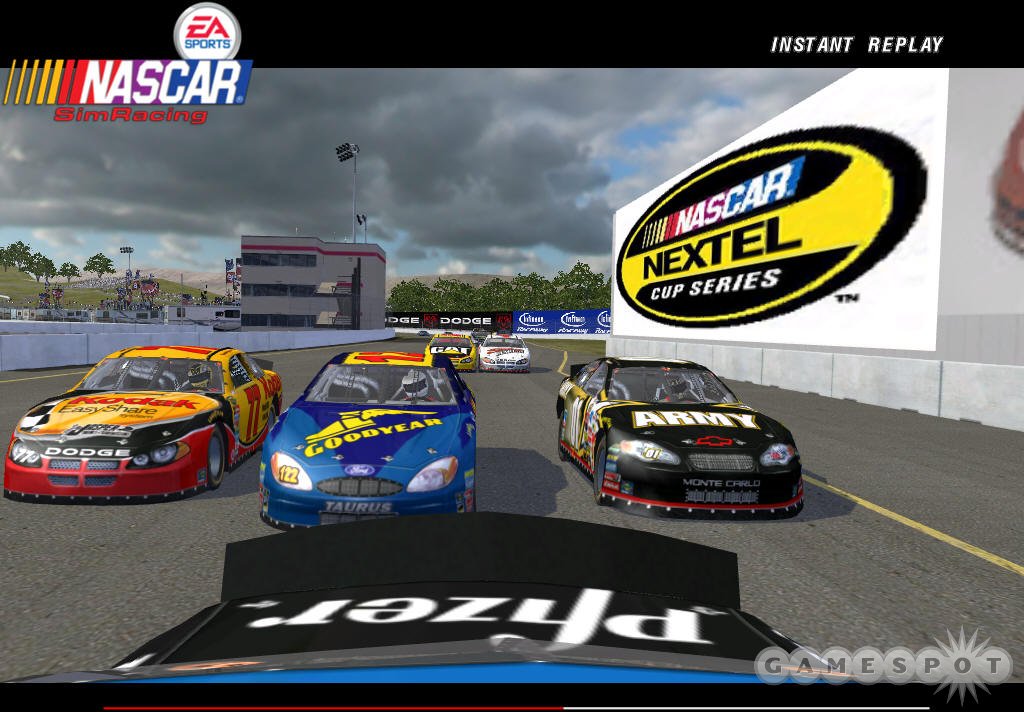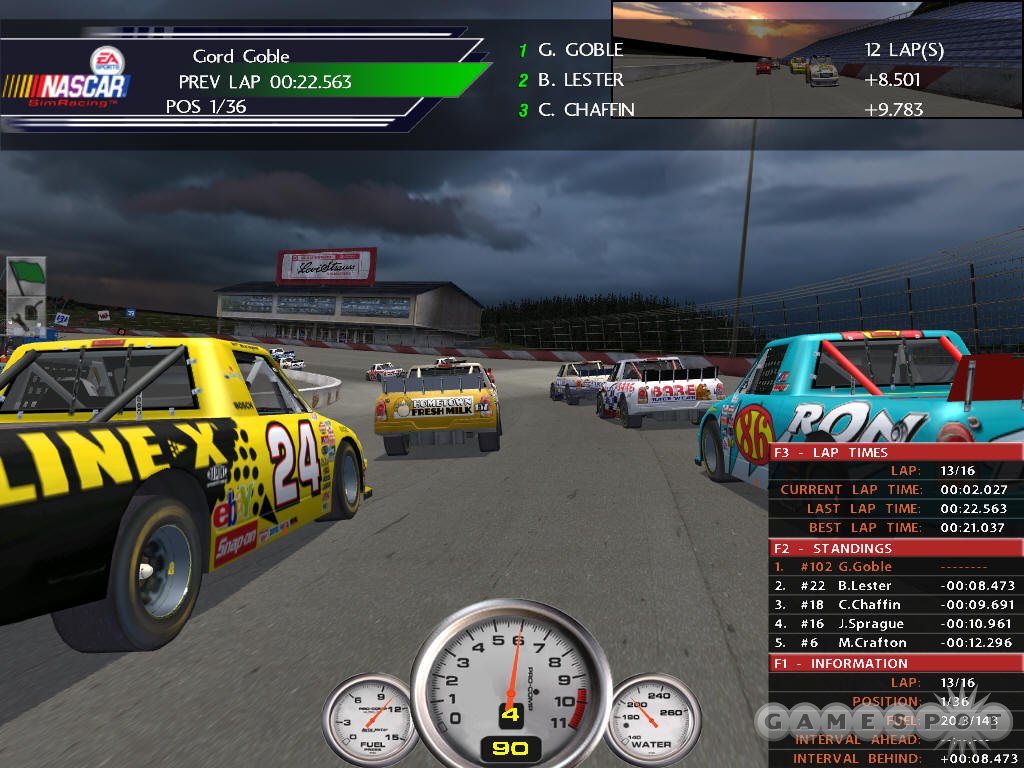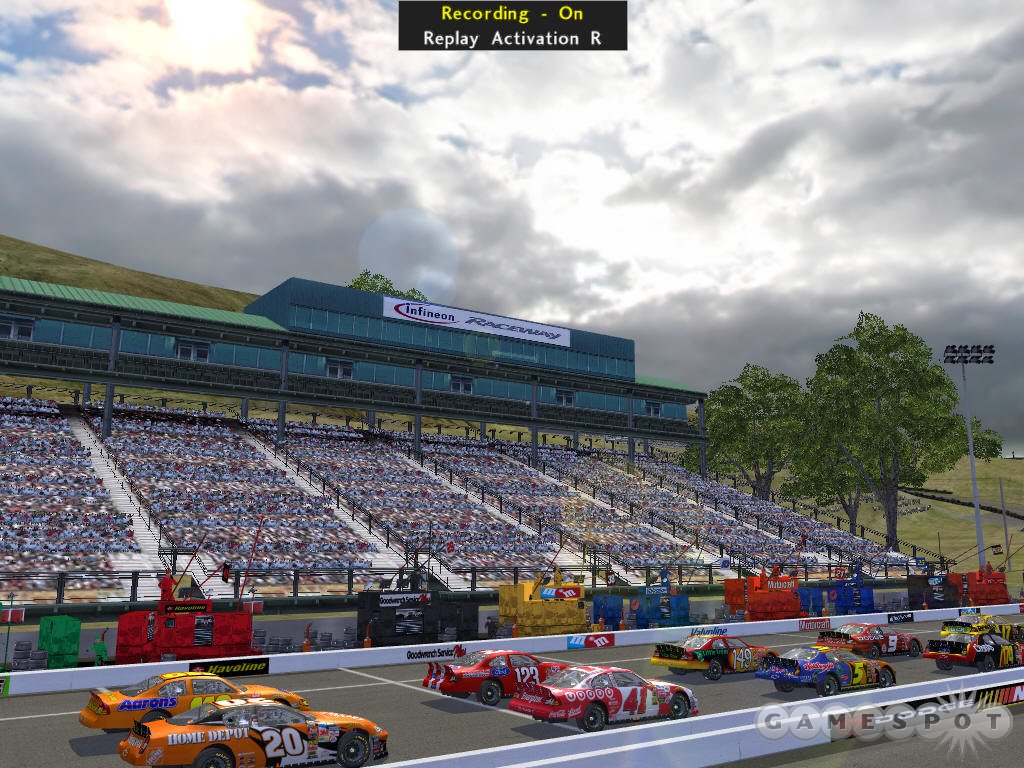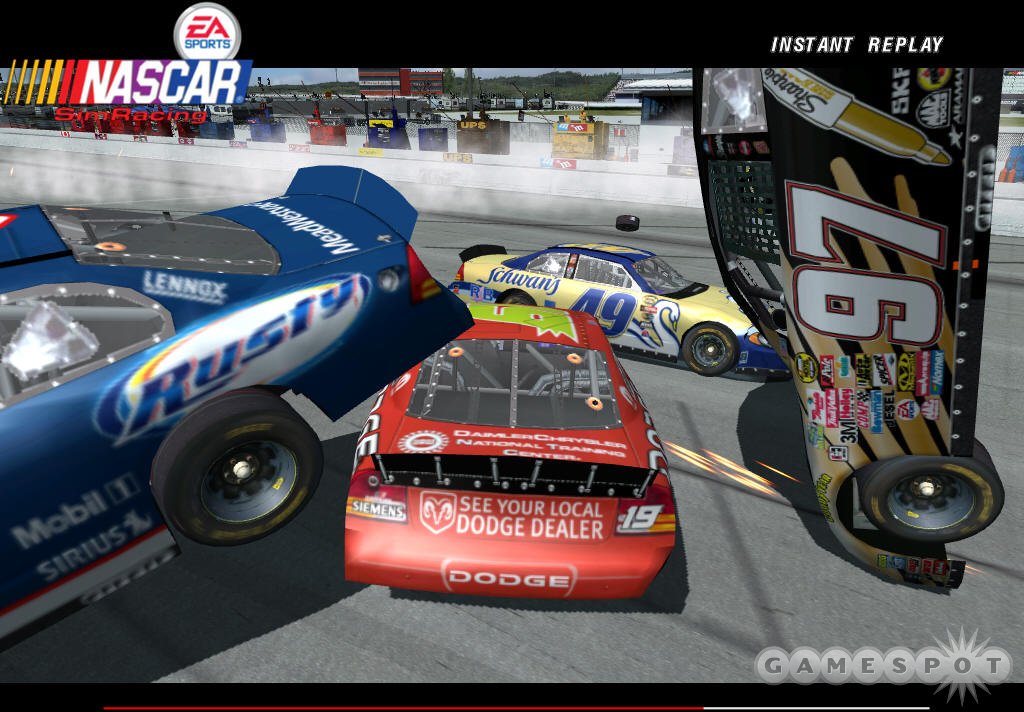With the doors at Papyrus Racing Games now firmly shuttered, and now that EA Sports has sewn up exclusive rights to develop and publish NASCAR-branded games until the end of the current decade, there's just one place for PC race fans to get their NASCAR fixes. Luckily for all concerned, that place is none too shabby. In its latest stock car opus, NASCAR SimRacing, EA Sports offers just about everything a racer could want (with the exception of a comprehensive printed manual) and works hard to satiate the thirsts of both the action/arcade crowd and the generally more demanding devotees of realistic/simulation competition. It has, for the most part, succeeded. Despite a few quirks, NASCAR SimRacing is a very workable journey into all corners of the NASCAR world, and the game's a real step forward for the EA Sports NASCAR franchise.

Like prior EA NASCAR titles, and like most EA titles regardless of the genre, for that matter, NASCAR SimRacing is a big, bold, brash and broad affair. And as expected, it sports full licensing for that ultrarealistic façade that's helped EA become the gaming juggernaut it is today. Certainly, if you want all the external NASCAR trappings, all the team and series sponsors, and all the appropriate team colors and paint schemes, you've come to the right place.
The game features no fewer than 28 tracks, 25 of which are culled from the real-life NASCAR circuit and three of which are pure fantasy. Nearly two dozen of them are ovals, but NASCAR SimRacing quickly dispels the wrongful notion that if you've seen one oval track you've seen them all. Indeed, each "roundy round" is a completely unique experience, from its character flaws (such as elevation variations, bumps, and width deviations) to its length, degree of banking, rubber-blackened racing line, and distinctive track surface.
You won't feel short of potential rides, either. More than five dozen vehicles and drivers are offered spanning NASCAR's three most important "leagues": the National Series, the Craftsman Truck Series, and the top-rung Nextel Cup Series. And, yes, there is some distinction between classes. Surely you'll find yourself moving much quicker and feeling more exposed to danger in a Nextel car than you would in a truck (which, of course, isn't a truck at all but is simply a slightly less powerful purpose-built racecar with a truck shell). By default, Nextel races are longer than those in the other two classes, and they're sometimes held at different tracks. Indeed, the three enclosed fantasy courses effectively take the place of Craftsman Truck and National tracks the game development team couldn't model due to insufficient data.
Undoubtedly, since EA Sports is now the sole provider of NASCAR PC games and must now answer to not only its already-established action/arcade fan base but also a legion of authenticity-craving Papyrus veterans, the big question is whether NASCAR SimRacing satisfactorily models a realistic stock car racing experience. The answer is yes.
Though it's no Grand Prix Legends in that it doesn't take the whole realism thing to frightening new heights, it does offer an equivalent experience to the vaunted Papyrus physics model as seen in that company's final NASCAR edition. You may not realize this, however, the first time you hit the track, especially since by default the game activates a sweeping collection of aids designed to simplify the experience for newcomers and "arcade" drivers. (Things become very different once you start removing these aids, though.)
NASCAR SimRacing does not fall victim to the pitfalls that have so often marred other racing games when they first ventured into the realm of simulation. Cars do not feel too loose, too tight, or too bizarrely magnetized to some preordained driving line. They most definitely ride upon four unique points, and their power-to-weight ratio seems bang on. If you get a little squirrelly, you can usually catch it if you exercise moderation and pay attention. If you don't, or if you keep a death grip on the stick, you're history. Much of your time will be spent preparing for turns, correcting yourself during them, and trying to slowly reel in and hopefully move smoothly past your peers. Fast oval setups pull noticeably to the left, and cold tires must warm sufficiently before you can really start moving around out there.
One complaint likely to rear its head over the course of the next few weeks and months is that the development team perhaps didn't go far enough. Even when all driver's aids are removed and difficulty levels are cranked, hardcore experts will likely wish for just a little more danger, just a bit more skittishness, and just a tad of that "edge of the envelope" feeling. But handling physics are just one part of the equation. The racing action must also be up to snuff, and indeed it is. In fact, NASCAR SimRacing delivers some of the best up close bumper-to-bumper dicing to ever grace the PC environment. In this game, drafting is critical...and the closer the better.

It's good then that the artificially intelligent drivers are both talented and skillfully aware of your presence. The truth is that they go out of their ways to avoid bopping you if you've done something stupid. And that's good news, because there's nothing worse than a great race ending suddenly and prematurely because of one microscopic slipup that probably wouldn't have occurred had you been in a real car on a real track.
This keen awareness is perhaps nowhere more evident than during those few milliseconds after you've passed a competitor in a turn and are then trying to gather your own car without grazing your competitor's nose with your tail. In the Papyrus version of NASCAR, this was always an inordinately difficult situation, often resulting in a rear-end nudge and a subsequent spin. In NASCAR SimRacing, a passed car is generally gracious enough to let you slot back into line. Even if you've pumped up the AI aggression, you aren't forced to stare down a bunch of suicidal maniacs. We would have preferred more independent collisions between AI vehicles, but maybe that will come in time.
Furthermore, those who don't occasionally bump and lean against competing cars will soon find themselves languishing behind, at least when the difficulty level is high. Indeed, car-to-car contact is common throughout, but it's an absolutely necessary part of the action if you want to win. More to the point, though, it's fun. It's really, really fun, especially considering the game's physics model permits car-to-car contact without activating a complete loss of adhesion. That's something you didn't find in the Papyrus product.

But if successfully competing at 95 or 100 percent difficulty is something you want to do, clean driving and mastery of your car are just the starting points. You'll also need to learn how to set up the darn game. The game offers a trio of default setups for each track, as well as three more "basic" adjustments (speed, handling, and response) to help get newbies acclimatized. But it also provides full garage facilities and sophisticated telemetry information for those who really want to get their hands dirty building the cars they'll need to emerge victoriously at the highest levels. And garage skill is an absolute must, as the game both enhances the capabilities of your opponents and makes your own car a bit less perfect as you incrementally dial in higher difficulty levels. Move from 85 to 95 percent difficulty, for example, and your once-smooth machine now redlines halfway down the front straight.
Once you get the hang of things, you'll undoubtedly want to engage in the game's career mode. Here, much of the silliness of past NASCAR Thunder careers has been eliminated in favor of a more subdued, realistic approach. Clearly, you'll quickly understand the meaning of consistency. You can win a ton of races, but if you're interspersing those victories with a fair share of sad-sack back-of-the-pack finishes or wipeouts, then you'll never rise to the top.
Otherwise, the career mode veritably brims with the same elements and situations facing a real-world team. Yet as promising as the concept seems from the outset, further investigation brings up holes. Simply put, the game doesn't go as far as it should. Yes, you'll involve yourself in research and development, thereby creating a much faster car, but it's all too easy. You merely dedicate funds to a given aspect (power, torque, grip, or aerodynamics) and then wait for a given number of races for that research to be completed. Applying more funds decreases the amount of time each new development takes, but there's, unfortunately, nothing deeper underneath. In the end, it all seems repetitious.
The world of sponsor relations is little better. You merely sign up as many sponsors as you can, and then you repeat the process as your contracts expire. There are no interesting asides, personality conflicts, or backroom battles. Moreover, your reputation bounces around like the scenery at a Hooters convention. We handily won three straight races and had top-dollar offers coming in from everywhere. We then experienced a single midpack finish and watched as our suitors, including "Little Tree Air Fresheners" for goodness sake, all but evaporated. We were informed that our reputation had taken a real beating. Later, following an event where we purposely demolished virtually every vehicle on the track, we were informed that our reputation had dropped "just a little." That's just wrong.
Yet if you can overlook some of the periphery, the career is generally an enjoyable place to be. Certainly it's a strong test of your overall ability. Additionally, several of the components are better and more sensible than those described above, and the nifty magazine headlines that highlight your latest triumphs are extremely cool.
As should be expected, especially given the visual beauty of EA's prior NASCAR efforts and the legacy of great-looking Papyrus products that are now no more (in part due to EA's exclusive NASCAR deal), NASCAR SimRacing is beautiful to behold. When run at its full graphical prowess, the game looks at least as good as the best NASCAR simulations to ever hit the market.
Apart from the true stars of the show--those distinctive tracks, sponsors, and vehicles described above--NASCAR SimRacing is perhaps most graphically notable for its superb depiction of real-time source-sensitive lighting and environmental conditions. Shadows from trackside objects move in accordance with the position of the sun. Even inside your cockpit, objects are bathed in light, then swamped by darkness. The black silhouettes under your opponent's cars swing to the right and left and fore and aft as the herd roars around the track. Indeed, so sophisticated is the play of grayscale variations on every nook and cranny of every vehicle that you'll swear you've been transported to some sort of TV land.

Day evolves smoothly into night, cloudy days become sunny, and all the while you'll witness the myriad subtle nuances that make the whole thing believable, including fighter-jet flyovers, circling helicopters, camera-wielding blimps, animated big-screen monitors, and all the offtrack periphery of a real event. Even the pit area is a lively affair, complete with animated crews flitting around your car, crew members jostling their pit boards, and more.
The game's overlaid display technology is excellent. Before each stint, you can decide if you want a low, medium, or large heads-up display to accompany your exterior perspectives. By toggling the lower F keys, you can summon all the critical facts and figures you need to properly manage your race, as well as signal the crew for your next stop. And, as has always been the case in late-model EA NASCAR titles, numerous other options are available to fine-tune your display and graphical qualities to best suit your own unique preferences. You can even moderate the width of your field of view and the scope of your driver's head movement.
Fans of fire and brimstone will, for the most part, be quite pleased. The game delivers varying levels of tire and engine smoke when the situation dictates it, and the game even goes so far as to both introduce a few flames and maintain the most powerful smoke shows for a half minute or so, which is enough to authentically camouflage most of the immediate area. The fire, conversely, is confined to short, smallish bursts from the engine compartment. Surely it isn't as hellish as it could be. Of potentially more concern are the occasional artifacts we saw during two separate stints. They were limited to the grandstands and therefore had little impact on the racing, but to see an entire section of seats and fans morph into space was weird, to say the least. Of course, your experience may vary.

As for car damage, you've come to the right place. NASCAR SimRacing cars break apart and shed parts as believably as most any driver could demand. Anyone conducting a search-and-destroy mission will soon find him- or herself surrounded by a bevy of cars in varying states of disrepair, so doorless, fenderless, bumperless, and tireless automobiles will be encountered. Walls display the black bruises of recent impacts, and tires and hoods bounce across the track until they magically disappear.
Sadly, the game's replay function is quite cumbersome. All the most desirable speed and editing controls are present and accounted for, but they're scattered oddly about the screen with little explanation, and they're given rudimentary appearances. Actually viewing your latest escapades is a lot of fun, especially considering the wide array of camera perspectives, but it's not as easy as it should be. During an event, you can access only the last lap or two. You can see an infinitely larger chunk after your race has ended, but you can only view it after sitting through a painfully lengthy replay-loading procedure. And this is just one of many spots where the proceedings seem to slow to a crawl.
In a word, NASCAR SimRacing's menu structure and navigation is clunky. If you want to enact even a minor settings or preference modification, you must seemingly wade through a flock of confusingly arranged, slowly transitioning interfaces to do so. If you feel the need to tweak your career or make a few changes prior to an event, the procedure is similarly sluggish. And when you load a track, be prepared to watch your fingernails grow while you wait. And wait.
Furthermore, you can't leap from one series' vehicle to another without unloading and reloading the track and jumping through a couple more hoops along the way. Nor can you quickly move to another track without first undergoing a whole bunch of menu navigation and waiting, once again, for that loading process to complete.
Another word of caution: Don't let those seemingly lightweight minimum system requirements fool you. Even the recommended requirements are a bit too liberal. Consequently, players who don't have high-end processors (2 to 3GHz Pentium 4s) and graphics cards (at least 128MB video RAM) and a minimum of 512MB RAM will be compelled to turn to the built-in graphical adjustment utility to get things flowing smoothly. Fortunately, there are oodles of possible video and audio alterations.
Interestingly, the development team opted to exclude integrated antialiasing. Instead, players must use the antialiasing features of their video cards. We cranked in the max antialiasing (4X) on our Radeon 9800 and were very pleased with the results, immediately saying goodbye to the sparkles and jaggies of the non-antialiased iteration.
Those who prefer trading paint with real, live humans rather than artificially intelligent CPU drivers will appreciate NASCAR SimRacing's impressive multiplayer element. Players already familiar with one another can dice it up via a local area network, but far more will presumably go mano a mano on the Internet. The game lets you do just that with up to 43 of your best friends (and most despised rivals), internally, through its multiplayer command and an active ea.com account.
We were privy to several multiplayer sessions just prior to the game's release and found it behaved quite well, even with a dozen players and a few AI cars simultaneously on the track. Warping was evident, but only minimally so and not too much to make the racing unbearable. As for frame rate, let's just say the game is best played online with its graphical detail level set to medium or below. Anything more and you'll quite probably endure a slide show. Fortunately, the scenery looks quite acceptable, even with reduced detail. EA assures us that multiplayer NASCAR is considered an extremely significant component, and as such, it will continually receive attention and enhancements as time goes on.

Audio aficionados will be happy to learn the game sounds great too. Talkative track announcers, spotters, and crew chiefs are just a small part of a comprehensive audible environment that also includes a very credible and always-informative representation of tire squeal and underbody scraping. And when you smack the wall or another car, there's definitely no question about it. The development team was somehow unable to capture that all-encompassing, echoing reverberation of four dozen monsters in a bullring that Papyrus did so well, but individual motors are convincingly guttural and bellowing. Assorted mechanical sounds and gear shifts are likewise gritty and plausible.
NASCAR SimRacing definitely cries out for a more thorough printed manual or guidebook (though EA will support it online via its Garage 101 component), and it also suffers from a few teething problems. But in the end, the decision to bring in tested personnel, like James Hawkins and several ex-Papyrus staffers, has clearly helped propel EA's NASCAR series to new heights. Approachable for newcomers and action racers yet challenging and believable enough for ardent sim buffs--and certainly pretty enough for all--NASCAR SimRacing looks to be in good hands and should only improve beyond its already praiseworthy state as time goes on.